-
 Iron tsuba of a round form (maru-gata) pierced (sukashi) with two six-petal flowers at 6 and 12 o’clock and modified lozenges at 3 and 9 o’clock, and inlaid in brass (suemon-zōgan) with tendrils and flowers (chrysanthemum, cherry blossom, Chinese bellflower, paulownia); openings outlined with scalloped brass wire. The plate is slightly concave with traces of lacquer on the surface. Nakago-ana plugged with copper sekigane. Some elements of inlay missing. The rim with conspicuous tekkotsu, quite worn. Measurements: Height 92.0 mm; Width 86.3 mm; thickness at seppa-dai 3.2 mm, at rim 4.2 mm. Time: Late Muromachi (1514 – 1573) or earlier.
Iron tsuba of a round form (maru-gata) pierced (sukashi) with two six-petal flowers at 6 and 12 o’clock and modified lozenges at 3 and 9 o’clock, and inlaid in brass (suemon-zōgan) with tendrils and flowers (chrysanthemum, cherry blossom, Chinese bellflower, paulownia); openings outlined with scalloped brass wire. The plate is slightly concave with traces of lacquer on the surface. Nakago-ana plugged with copper sekigane. Some elements of inlay missing. The rim with conspicuous tekkotsu, quite worn. Measurements: Height 92.0 mm; Width 86.3 mm; thickness at seppa-dai 3.2 mm, at rim 4.2 mm. Time: Late Muromachi (1514 – 1573) or earlier. -
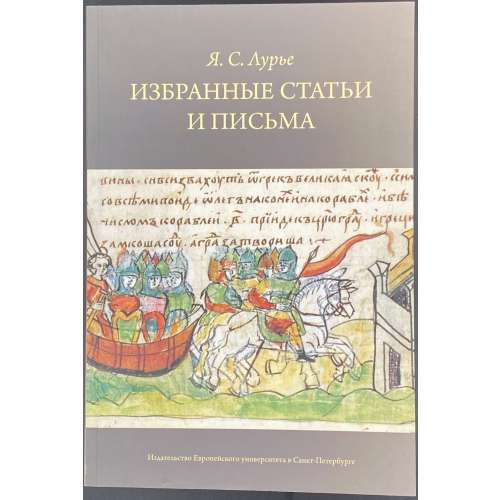 Paperback, pictorial wrappers, 20.5 x 14 cm, pp.: [1-4] 5-271 [272 colophon]. Title-page: Я. С. Лурье | ИЗБРАННЫЕ СТАТЬИ | И ПИСЬМА | Санкт-Петербург 2011 || Contributors: Яков Соломонович Лурье (Russian-Jewish, 1921 — 1996) Варвара Гелиевна Вовина-Лебедева (Russian, b. 1961) Михаил Маркович Кром (Russian, b. 1966)
Paperback, pictorial wrappers, 20.5 x 14 cm, pp.: [1-4] 5-271 [272 colophon]. Title-page: Я. С. Лурье | ИЗБРАННЫЕ СТАТЬИ | И ПИСЬМА | Санкт-Петербург 2011 || Contributors: Яков Соломонович Лурье (Russian-Jewish, 1921 — 1996) Варвара Гелиевна Вовина-Лебедева (Russian, b. 1961) Михаил Маркович Кром (Russian, b. 1966) -
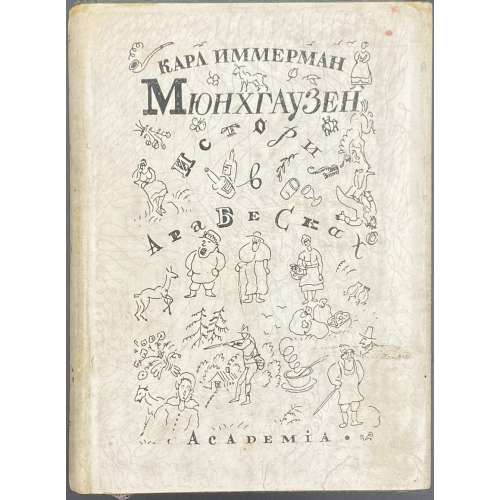
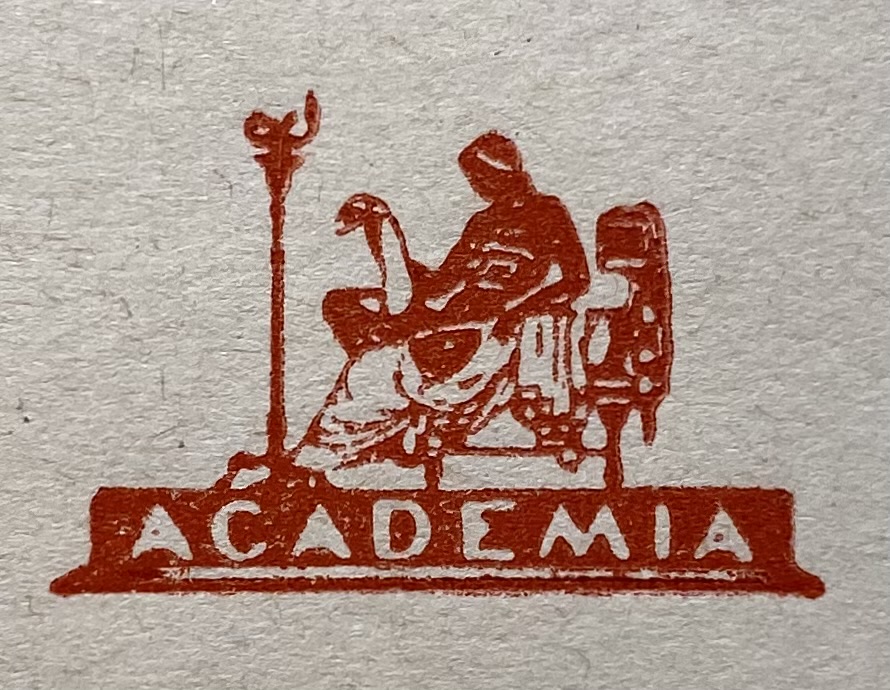 The book Münchhausen: eine Geschichte in Arabesken by Karl Leberecht Immermann was published in Düsseldorf by J. E. Shaub in 1838-1839. Its Russian translation by the Yarkho brothers was published in 1931 and 1932 by Academia publishing in two volumes uniformly bound in full green cloth with embossed and gilt pictorial design to front cover and spine, 17.3 x 12.5 cm, pictorial endpapers, top margin red, and pictorial dust jacket.
Vol. I: 8vo, [1]-398 (312 leaves, 10 plates within collation); pp.: [1-7] 8-624. Print run 5,000 copies.
Title-page (red and black): КАРЛ ИММЕРМАН | Мюнхгаузен | История | в арабесках | перевод и примечания | Г. И. и Б. И. Ярхо | ПРЕДИСЛОВИЕ | П. С. КОГАНА | I | {vignette} | ~ ACADEMIA ~ | МОСКВА ~ ЛЕНИНГРАД | 1931 ||
Frontispiece (red and black): СОКРОВИЩА | МИРОВОЙ ЛИТЕРАТУРЫ | КАРЛ ИММЕРМАН | МЮНХГАУЗЕН | {fleuron} | * | ~ ACADEMIA ~ | МОСКВА ~ ЛЕНИНГРАД | 1931 ||
Reverse title: KARL IMMERMANN | MÜNCHHAUSEN | Eine Geschichte in Arabesken | {…} | ИЛЛЮСТРАЦИИ, ТИТУЛ, | ТИСНЕНИЕ НА ПЕРЕПЛЕТЕ | И СУПЕРОБЛОЖКА ПО РИС. | ХУД. Д. И. МИТРОХИНА | {…} | Ленинградский Областлит № 64832. | Тир. 5.000—39 листов. Зак. 7167. | Государственная типография | “Ленинградская Правда”, | Ленинград. | Соц. 14. ||
Vol. 2: 8vo, [1] 398 ( 312 leaves, 14 plates within collation), pp.: [1-7] 8-622 [2 colophon/blank]. Print run 5,250 copies.
Title-page (red and black): КАРЛ ИММЕРМАН | Мюнхгаузен | История | в арабесках | перевод и примечания | Б. И. и Г. И. Ярхо | II | {vignette} | ~ ACADEMIA ~ | МОСКВА ~ ЛЕНИНГРАД | 1932 ||
Frontispiece: СОКРОВИЩА | МИРОВОЙ ЛИТЕРАТУРЫ | КАРЛ ИММЕРМАН | МЮНХГАУЗЕН | {fleuron} | * | ~ ACADEMIA ~ | МОСКВА ~ ЛЕНИНГРАД | 1932 ||
Reverse title: KARL IMMERMANN | MUNCHHAUSEN | Eine Geschichte in Arabesken | {…} | Иллюстрации, титул, тиснение | на переплете | и суперобложка | по рис. худ. Д. И. Митрохина.
Illustrations: Plates, title pages, faux-titles, head- and endpieces, design of covers and dust jackets after Dmitry Mitrokhin (Д. И. Митрохин).
Catalogue raisonné: Крылов-Кичатова v.1: 451/2, v.2: 491. [LIB-2260.2019].
Contributors:
Karl Leberecht Immermann (German, 1796 – 1840) – author.
Григорий Исаакович Ярхо (Russian-Jewish, 1886 – 1954) – translator.
Борис Исаакович Ярхо (Russian-Jewish,1889 – 1942) – translator.
Пётр Семёнович Коган (Russian-Jewish, 1872 – 1932) – author/preface.
Dmitry Mitrokhin [Дмитрий Исидорович Митрохин] (Russian, 1883 – 1973) – artist.
The book Münchhausen: eine Geschichte in Arabesken by Karl Leberecht Immermann was published in Düsseldorf by J. E. Shaub in 1838-1839. Its Russian translation by the Yarkho brothers was published in 1931 and 1932 by Academia publishing in two volumes uniformly bound in full green cloth with embossed and gilt pictorial design to front cover and spine, 17.3 x 12.5 cm, pictorial endpapers, top margin red, and pictorial dust jacket.
Vol. I: 8vo, [1]-398 (312 leaves, 10 plates within collation); pp.: [1-7] 8-624. Print run 5,000 copies.
Title-page (red and black): КАРЛ ИММЕРМАН | Мюнхгаузен | История | в арабесках | перевод и примечания | Г. И. и Б. И. Ярхо | ПРЕДИСЛОВИЕ | П. С. КОГАНА | I | {vignette} | ~ ACADEMIA ~ | МОСКВА ~ ЛЕНИНГРАД | 1931 ||
Frontispiece (red and black): СОКРОВИЩА | МИРОВОЙ ЛИТЕРАТУРЫ | КАРЛ ИММЕРМАН | МЮНХГАУЗЕН | {fleuron} | * | ~ ACADEMIA ~ | МОСКВА ~ ЛЕНИНГРАД | 1931 ||
Reverse title: KARL IMMERMANN | MÜNCHHAUSEN | Eine Geschichte in Arabesken | {…} | ИЛЛЮСТРАЦИИ, ТИТУЛ, | ТИСНЕНИЕ НА ПЕРЕПЛЕТЕ | И СУПЕРОБЛОЖКА ПО РИС. | ХУД. Д. И. МИТРОХИНА | {…} | Ленинградский Областлит № 64832. | Тир. 5.000—39 листов. Зак. 7167. | Государственная типография | “Ленинградская Правда”, | Ленинград. | Соц. 14. ||
Vol. 2: 8vo, [1] 398 ( 312 leaves, 14 plates within collation), pp.: [1-7] 8-622 [2 colophon/blank]. Print run 5,250 copies.
Title-page (red and black): КАРЛ ИММЕРМАН | Мюнхгаузен | История | в арабесках | перевод и примечания | Б. И. и Г. И. Ярхо | II | {vignette} | ~ ACADEMIA ~ | МОСКВА ~ ЛЕНИНГРАД | 1932 ||
Frontispiece: СОКРОВИЩА | МИРОВОЙ ЛИТЕРАТУРЫ | КАРЛ ИММЕРМАН | МЮНХГАУЗЕН | {fleuron} | * | ~ ACADEMIA ~ | МОСКВА ~ ЛЕНИНГРАД | 1932 ||
Reverse title: KARL IMMERMANN | MUNCHHAUSEN | Eine Geschichte in Arabesken | {…} | Иллюстрации, титул, тиснение | на переплете | и суперобложка | по рис. худ. Д. И. Митрохина.
Illustrations: Plates, title pages, faux-titles, head- and endpieces, design of covers and dust jackets after Dmitry Mitrokhin (Д. И. Митрохин).
Catalogue raisonné: Крылов-Кичатова v.1: 451/2, v.2: 491. [LIB-2260.2019].
Contributors:
Karl Leberecht Immermann (German, 1796 – 1840) – author.
Григорий Исаакович Ярхо (Russian-Jewish, 1886 – 1954) – translator.
Борис Исаакович Ярхо (Russian-Jewish,1889 – 1942) – translator.
Пётр Семёнович Коган (Russian-Jewish, 1872 – 1932) – author/preface.
Dmitry Mitrokhin [Дмитрий Исидорович Митрохин] (Russian, 1883 – 1973) – artist.
-
 Title: Modori Kago [戻駕] (Returning palanquin). The dance-drama Modori Kago Iro ni Aikata [戻駕色相肩] premiered in the 11th lunar month of 1788 at the Nakamuraza [中村座], within Sakurada Jisuke I's kaomise [顔見世] (faceshowing) program Tôzumô Hana no Edogata [唐相撲花江戸方]", which celebrated the homecoming to Edo, after two years' absence, of Nakamura Nakazō I, and was intended to show off his particular talents in the role of Jirosaku (in reality Ishikawa Goemon [石川 五右衛門]) [kabuki21]. The symbol on a green book cover is the informal crest of tokiwazu-bushi [常磐津節] shaped like a water chestnut (Eleocharis dulcis) lozenge. Artist signature 国盛画 (Kunimori ga) with red toshidama. According to Samuel L. Leiter’s Kabuki Encyclopedia (1979), p. 243: The palanquin bearers Nanpa no Jirosaku and Azuma no Yōshirō, who are bearing a palanquin with a courtesan's young handmaiden in it, stop to rest at Kyoto's Murasakino, and each dances his regional dance. Then they call the girl, who does a dance showing the visitors to the famous pleasure quarters, Yoshiwara and Shimabara. The two men recognize each other as Ishikawa Goemon and Masashiba Hisayoshi, sworn enemies, and engage in a fight. This number is the only remaining section of an annual "faceshowing” (kaomize) work with a plot based on the medieval chronicle called the Toikōki. The full-length piece was called Kara Sumō Hanaeda no Kata. It is one of the most famous tokiwazu pieces and preserves the old-style Kabuki flavour. Nakamura Nakazō I played Jirosaku and Matsumoto Kōshirō IV was Yoshiro in the first production. The handmaiden was Matsumoto Komesaburō (probably Matsumoto Komasaburō I, an unknown actor [SV]). According to Egenolf Gallery: This work was first performed in 1788 at the Edo Nakamura-za as the season’s first performance and featured Nakamura Nakazō, who returned to Edo after three years in Osaka. It was a dance with tokiwazu chanting and was designed for him to play the lead role. In the piece, two palanquin carriers, one from Osaka, another from Edo, and a passenger – a kamuro, (a young geisha-in-training) exchange stories about the pleasure quarters of Shimabara and Yoshiwara. The text of the chanting book is open next to her, carrying the title “Collection of Practicing” [稽古尽くし], on which the green bundle cover carries the crest of Tokiwazu School, matsu-kawa-bishi, diamond variety of pine bark and the artist’s signature. Tokiwazu is a type of jōruri, narrative music, and accompanies dancing on the kabuki stage. Ref.: Christie's 27 Mar 2006. Publisher: Maruya Jinpachi, seal Marujin (Marks: 12-029 | 294e) Single nanushi censor seal: Mura (Murata Sahei, 1842-46). Provenance: Circular seal of the collector Huguette Bérès to verso. Contributors: Utagawa Kunimori [歌川国盛] (Japanese, fl. c. 1818 – 1943) – artist. Maruya Jinpachi [丸屋甚八] (Japanese, fl. 1770 – 1842) – publisher. Other mentioned: Nakamura Nakazō I [中村仲蔵] (Japanese, 1736 – 1790); other names: Nakayama Kojūrō VI, Nakamura Ichijūrō, Nakayama Manzō – actor. Matsumoto Kōshirō IV [松本幸四郎] (Japanese, 1737 – 1802); other names: Omegawa Kyōjūrō; Ichikawa Komazō II, Ichikawa Somegorô I, Ichikawa Takejūrō ; Segawa Kinji; Segawa Kingo – actor. Sakurada Jisuke I [桜田治助] (Japanese, 1734 – 1806) – dramatist.
Title: Modori Kago [戻駕] (Returning palanquin). The dance-drama Modori Kago Iro ni Aikata [戻駕色相肩] premiered in the 11th lunar month of 1788 at the Nakamuraza [中村座], within Sakurada Jisuke I's kaomise [顔見世] (faceshowing) program Tôzumô Hana no Edogata [唐相撲花江戸方]", which celebrated the homecoming to Edo, after two years' absence, of Nakamura Nakazō I, and was intended to show off his particular talents in the role of Jirosaku (in reality Ishikawa Goemon [石川 五右衛門]) [kabuki21]. The symbol on a green book cover is the informal crest of tokiwazu-bushi [常磐津節] shaped like a water chestnut (Eleocharis dulcis) lozenge. Artist signature 国盛画 (Kunimori ga) with red toshidama. According to Samuel L. Leiter’s Kabuki Encyclopedia (1979), p. 243: The palanquin bearers Nanpa no Jirosaku and Azuma no Yōshirō, who are bearing a palanquin with a courtesan's young handmaiden in it, stop to rest at Kyoto's Murasakino, and each dances his regional dance. Then they call the girl, who does a dance showing the visitors to the famous pleasure quarters, Yoshiwara and Shimabara. The two men recognize each other as Ishikawa Goemon and Masashiba Hisayoshi, sworn enemies, and engage in a fight. This number is the only remaining section of an annual "faceshowing” (kaomize) work with a plot based on the medieval chronicle called the Toikōki. The full-length piece was called Kara Sumō Hanaeda no Kata. It is one of the most famous tokiwazu pieces and preserves the old-style Kabuki flavour. Nakamura Nakazō I played Jirosaku and Matsumoto Kōshirō IV was Yoshiro in the first production. The handmaiden was Matsumoto Komesaburō (probably Matsumoto Komasaburō I, an unknown actor [SV]). According to Egenolf Gallery: This work was first performed in 1788 at the Edo Nakamura-za as the season’s first performance and featured Nakamura Nakazō, who returned to Edo after three years in Osaka. It was a dance with tokiwazu chanting and was designed for him to play the lead role. In the piece, two palanquin carriers, one from Osaka, another from Edo, and a passenger – a kamuro, (a young geisha-in-training) exchange stories about the pleasure quarters of Shimabara and Yoshiwara. The text of the chanting book is open next to her, carrying the title “Collection of Practicing” [稽古尽くし], on which the green bundle cover carries the crest of Tokiwazu School, matsu-kawa-bishi, diamond variety of pine bark and the artist’s signature. Tokiwazu is a type of jōruri, narrative music, and accompanies dancing on the kabuki stage. Ref.: Christie's 27 Mar 2006. Publisher: Maruya Jinpachi, seal Marujin (Marks: 12-029 | 294e) Single nanushi censor seal: Mura (Murata Sahei, 1842-46). Provenance: Circular seal of the collector Huguette Bérès to verso. Contributors: Utagawa Kunimori [歌川国盛] (Japanese, fl. c. 1818 – 1943) – artist. Maruya Jinpachi [丸屋甚八] (Japanese, fl. 1770 – 1842) – publisher. Other mentioned: Nakamura Nakazō I [中村仲蔵] (Japanese, 1736 – 1790); other names: Nakayama Kojūrō VI, Nakamura Ichijūrō, Nakayama Manzō – actor. Matsumoto Kōshirō IV [松本幸四郎] (Japanese, 1737 – 1802); other names: Omegawa Kyōjūrō; Ichikawa Komazō II, Ichikawa Somegorô I, Ichikawa Takejūrō ; Segawa Kinji; Segawa Kingo – actor. Sakurada Jisuke I [桜田治助] (Japanese, 1734 – 1806) – dramatist. -
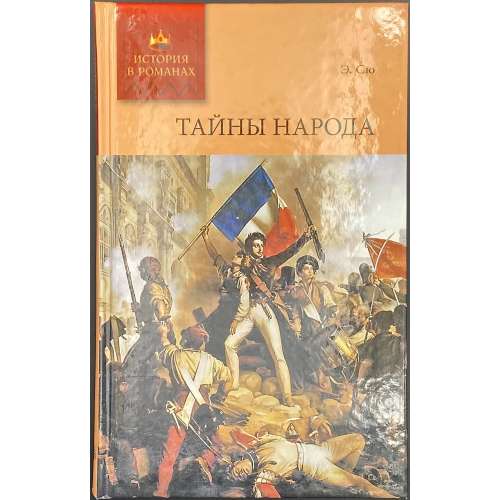 Hardcover volume, 20.7 x 13.2 cm, in glossy paper pictorial boards, blurb to back, lettering to spine, pp.: [1-4] 5-221 [3]. Title-page: {meander} {banner: crawn} | ИСТОРИЯ | В РОМАНАХ {meander} | Э. Сю | ТАЙНЫ НАРОДА | {device МИР КНИГИ} {device Литература} | {meander} || Faux-title: {meander} | ТАЙНЫ НАРОДА | История одного семейства | {meander} || Print run: 3,500 copies. Contributors: Eugène Sue [Эжен Сю] (French, 1804 – 1857) – author О. Иванова, О. Григорьева, Л. Белевич – translators. Original:Eugène Sue. Les mystères du peuple ou Histoire d’une famille de prolétaires à travers les âges. — Paris Administration de librairie, 1849-1857 (16 vol.), according to Worldcat 68 editions published between 1850 and 2003.
Hardcover volume, 20.7 x 13.2 cm, in glossy paper pictorial boards, blurb to back, lettering to spine, pp.: [1-4] 5-221 [3]. Title-page: {meander} {banner: crawn} | ИСТОРИЯ | В РОМАНАХ {meander} | Э. Сю | ТАЙНЫ НАРОДА | {device МИР КНИГИ} {device Литература} | {meander} || Faux-title: {meander} | ТАЙНЫ НАРОДА | История одного семейства | {meander} || Print run: 3,500 copies. Contributors: Eugène Sue [Эжен Сю] (French, 1804 – 1857) – author О. Иванова, О. Григорьева, Л. Белевич – translators. Original:Eugène Sue. Les mystères du peuple ou Histoire d’une famille de prolétaires à travers les âges. — Paris Administration de librairie, 1849-1857 (16 vol.), according to Worldcat 68 editions published between 1850 and 2003. -
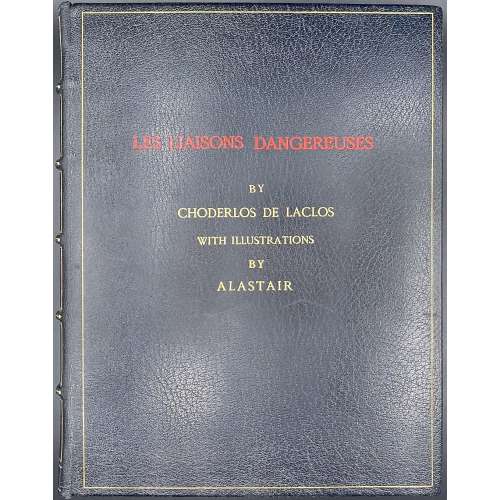 Hardcover, 28.3 x 22.5 cm, two volumes bound in one in full navy crushed morocco by Zaehnsdorf for E. Joseph (signed), border fillet and red and gilt lettering to front, spine with raised bands outlined in gilt, red and gilt lettering in compartments, gilt dentelle, blue moire endpapers, all margins gilt; one of the original wrappers preserved, 14 tissue-guarded colour woodcuts after Alastair; text in black with red titles and initials (hand-set type), and the illustrations printed on watermarked ‘Moirans’ laid paper. Title-page (red and black): Les Liaisons Dangereuses | by | CHODERLOS DE LACLOS | With Illustrations | by | ALASTAIR | THE BLACK SUN PRESS | DEUX RUE CARDINALE | PARIS | MCMXXIX || Limitation: a print run of 1020 copies: 15 on Japon, 1000 on Moirans and 5 NFS; this is copy № 143 (vol. 1) and 303 (vol. 2) Contributors: Pierre Choderlos de Laclos (French, 1741 – 1803) – author. Ernest Christopher Dowson (British, 1867 – 1900) – translator. Alastair [Hans-Henning Baron von Voigt] (German, 1887 – 1969) – artist. Comte Ulric de Civry (French, 1853 – 1935) – dedicatee. Black Sun Press (1927 – 1970) – publishing company. Harry Crosby (American, 1898 – 1929) – publisher. Caresse Crosby [Mary Phelps Jacob] (American, 1892 – 1970) – publisher. Joseph William Zaehnsdorf (Austrian, 1853 – 1930) – bookbinder.
Hardcover, 28.3 x 22.5 cm, two volumes bound in one in full navy crushed morocco by Zaehnsdorf for E. Joseph (signed), border fillet and red and gilt lettering to front, spine with raised bands outlined in gilt, red and gilt lettering in compartments, gilt dentelle, blue moire endpapers, all margins gilt; one of the original wrappers preserved, 14 tissue-guarded colour woodcuts after Alastair; text in black with red titles and initials (hand-set type), and the illustrations printed on watermarked ‘Moirans’ laid paper. Title-page (red and black): Les Liaisons Dangereuses | by | CHODERLOS DE LACLOS | With Illustrations | by | ALASTAIR | THE BLACK SUN PRESS | DEUX RUE CARDINALE | PARIS | MCMXXIX || Limitation: a print run of 1020 copies: 15 on Japon, 1000 on Moirans and 5 NFS; this is copy № 143 (vol. 1) and 303 (vol. 2) Contributors: Pierre Choderlos de Laclos (French, 1741 – 1803) – author. Ernest Christopher Dowson (British, 1867 – 1900) – translator. Alastair [Hans-Henning Baron von Voigt] (German, 1887 – 1969) – artist. Comte Ulric de Civry (French, 1853 – 1935) – dedicatee. Black Sun Press (1927 – 1970) – publishing company. Harry Crosby (American, 1898 – 1929) – publisher. Caresse Crosby [Mary Phelps Jacob] (American, 1892 – 1970) – publisher. Joseph William Zaehnsdorf (Austrian, 1853 – 1930) – bookbinder. -
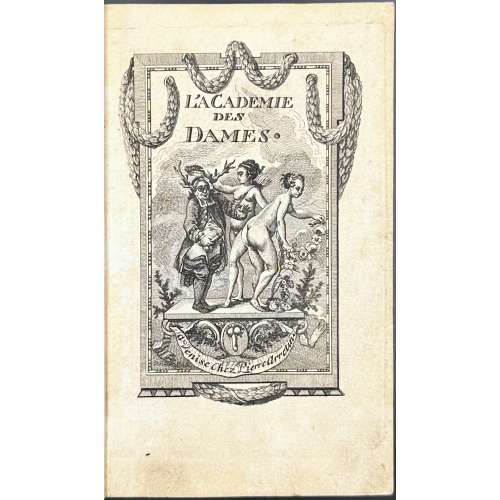 A set of two volumes, one with the text (1) and another with the plates (2), cased in a red ‘romantic’ fitting box of red morocco, lavishly tooled in gilt, c. 1840, more recently adapted to house two books of different size. Vol.1: Hardcover volume, 22.4 x 14 cm, 8vo, bound in half black polished calf (late 19th century) over marbled boards, spine and corners gilt-tooled, raised bands, gilt lozenges in compartments, gilt-lettered red morocco label; marbled endpapers; Francis M. G. Mauleverer armorial bookplate (motto “Deus Providebit”) to front pastedown. Printed on laid paper, Collation: 1 blank, engraved frontis., engraved t.p., A-Cc8 Dd2, 1 blank; pagination:[1] 2-420. Vol. 2: Hardcover volume, 21 x 14 cm, bound in green straight-grain morocco (early 19th century), boards with a roll-tooled palmette border, spine decorated in gilt, blue moiré endpapers, yellow feps, additional blank leaves: 2 in the front and 4 in the back, unpaginated; engraved frontis. and t.p. as in vol. 2, plus 35 plates now attributed to Delcroche printed on India paper, pasted on thicker leaves and bound in numerical order, but pl. 34 after pl. 35; As per Christie’s “The prints, sometimes attributed to de Hooghe, are actually by Delcroche, who illustrated a number of classics in the 1770s and 1780s, including Fanny Hill. AE and ABPC record only three copies of this edition at auction, including the Nordmann and Hayoit copies. Apollinaire Enfer, 277; Dutel A-15; Eros invaincu 16; Foxon Libertine Literature, NY: 1965, p.38; Gay-Lemonnyer I, 10; Pia Enfer, 346.” Contributors: Delcroche (Dutch, 17th century), “artiste hollandaise”, nothing else is known. Dutel and Nordmann attribute the plates to Romeyn de Hooghe (Dutch, 1645 – 1708). Nicolas Chorier (French, 1612 – 1692) – author. Francis M. G. Mauleverer (British, 1918 – 1962) – provenance. Seller’s description: 2 vols in 8vo (215x125 and 204x117 mm), a complete but composite set, the text volume in late 19th c. half black morocco, with corners, gilt spine tooled in gold, the plate volume in a nice early 19th-century green morocco binding, the spine gilt-tooled in compartments, the sides with a roll-tooled palmette border, pale blue moiré style endpapers (hinges repaired). Text vol.: engraved frontispiece, engr. title, pp. 420. Plates vol. comprising: the engraved title, frontispiece, and 35 engraved plates, probably by Delcroche. Both volumes cased in a ‘romantic’ fitting box binding, c. 1840, more recently adapted.
A set of two volumes, one with the text (1) and another with the plates (2), cased in a red ‘romantic’ fitting box of red morocco, lavishly tooled in gilt, c. 1840, more recently adapted to house two books of different size. Vol.1: Hardcover volume, 22.4 x 14 cm, 8vo, bound in half black polished calf (late 19th century) over marbled boards, spine and corners gilt-tooled, raised bands, gilt lozenges in compartments, gilt-lettered red morocco label; marbled endpapers; Francis M. G. Mauleverer armorial bookplate (motto “Deus Providebit”) to front pastedown. Printed on laid paper, Collation: 1 blank, engraved frontis., engraved t.p., A-Cc8 Dd2, 1 blank; pagination:[1] 2-420. Vol. 2: Hardcover volume, 21 x 14 cm, bound in green straight-grain morocco (early 19th century), boards with a roll-tooled palmette border, spine decorated in gilt, blue moiré endpapers, yellow feps, additional blank leaves: 2 in the front and 4 in the back, unpaginated; engraved frontis. and t.p. as in vol. 2, plus 35 plates now attributed to Delcroche printed on India paper, pasted on thicker leaves and bound in numerical order, but pl. 34 after pl. 35; As per Christie’s “The prints, sometimes attributed to de Hooghe, are actually by Delcroche, who illustrated a number of classics in the 1770s and 1780s, including Fanny Hill. AE and ABPC record only three copies of this edition at auction, including the Nordmann and Hayoit copies. Apollinaire Enfer, 277; Dutel A-15; Eros invaincu 16; Foxon Libertine Literature, NY: 1965, p.38; Gay-Lemonnyer I, 10; Pia Enfer, 346.” Contributors: Delcroche (Dutch, 17th century), “artiste hollandaise”, nothing else is known. Dutel and Nordmann attribute the plates to Romeyn de Hooghe (Dutch, 1645 – 1708). Nicolas Chorier (French, 1612 – 1692) – author. Francis M. G. Mauleverer (British, 1918 – 1962) – provenance. Seller’s description: 2 vols in 8vo (215x125 and 204x117 mm), a complete but composite set, the text volume in late 19th c. half black morocco, with corners, gilt spine tooled in gold, the plate volume in a nice early 19th-century green morocco binding, the spine gilt-tooled in compartments, the sides with a roll-tooled palmette border, pale blue moiré style endpapers (hinges repaired). Text vol.: engraved frontispiece, engr. title, pp. 420. Plates vol. comprising: the engraved title, frontispiece, and 35 engraved plates, probably by Delcroche. Both volumes cased in a ‘romantic’ fitting box binding, c. 1840, more recently adapted. -
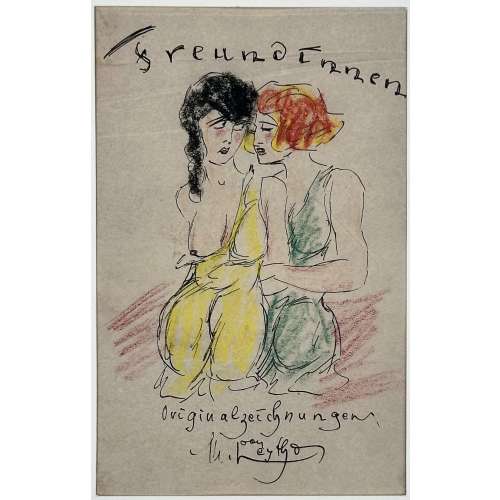 Seven pen and ink and colour crayon drawings on thin wove paper approx. 140 x 100 mm, each attached to a sheet 310 x 240 mm and mounted in a passepartout, placed in an aubergine cardboard folder 310 x 250 mm with a tan vellum spine and paper flaps inside; olive label with double border and gilt lettering to front cover "Dessins" [Drawings]. The first sheet is a title-page lettered in manuscript: Freundinnen | {vignette} | Originalzeichnungen | M. Leytho || [Girlfriends. Original drawings]. Information about the artist at www.honesterotica.com: "Mitja Leytho, almost certainly a pseudonym, is yet another mediocre yet fascinating amateur artist from the Germany of the 1920s about whom we know absolutely nothing beyond the four portfolios which bear the ‘Leytho’ signature". We shall notice that this set of drawings was produced by a talented professional, not an amateur.
Seven pen and ink and colour crayon drawings on thin wove paper approx. 140 x 100 mm, each attached to a sheet 310 x 240 mm and mounted in a passepartout, placed in an aubergine cardboard folder 310 x 250 mm with a tan vellum spine and paper flaps inside; olive label with double border and gilt lettering to front cover "Dessins" [Drawings]. The first sheet is a title-page lettered in manuscript: Freundinnen | {vignette} | Originalzeichnungen | M. Leytho || [Girlfriends. Original drawings]. Information about the artist at www.honesterotica.com: "Mitja Leytho, almost certainly a pseudonym, is yet another mediocre yet fascinating amateur artist from the Germany of the 1920s about whom we know absolutely nothing beyond the four portfolios which bear the ‘Leytho’ signature". We shall notice that this set of drawings was produced by a talented professional, not an amateur. -
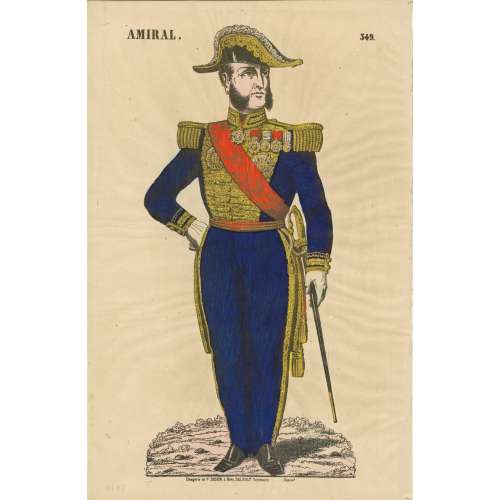 Hand-coloured woodcut on wove paper, 440 x 285 mm; black ink stamp “5049” to reverse. Top left: "AMIRAL"; right: "349". Below: "Imagerie de DIDION, à Metz, DELHALT Successeur." — "Déposé." Paulin Didion (French, 1831 – 1879) – publisher/printer.
Hand-coloured woodcut on wove paper, 440 x 285 mm; black ink stamp “5049” to reverse. Top left: "AMIRAL"; right: "349". Below: "Imagerie de DIDION, à Metz, DELHALT Successeur." — "Déposé." Paulin Didion (French, 1831 – 1879) – publisher/printer. -
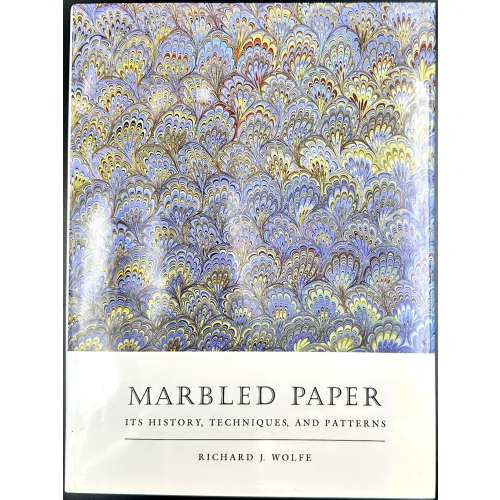 Hardcover volume, 311 x 235 mm, bound in blue cloth, gilt lettering to spine, olive endpapers, pictorial dust jacket with text to flaps, pp.: [i-xi] xii-xvi, [1] 2-245 [246 blank], plus 19 leaves of plates and 4 leaves of captions, extraneous to collation (169 leaves total). Title-page: MARBLED | PAPER | ITS HISTORY, TECHNIQUES, | AND PATTERNS | With Special Reference to the Relationship of | Marbling to Bookbinding in Europe and | the Western World | RICHARD J. WOLFE {publisher’s device} | UNIVERSITY OF PENNSYLVANIA PRESS | Philadelphia || Imprint: Copyright © 1990 by the University of Pennsylvania Press | All rights reserved | Printed in Japan | Second printing 1991 || Frontispiece: A Publication of the | A. S. W. ROSENBACH FELLOWSHIP | IN BIBLIOGRAPHY || Wolfe, Richard J. (American, 1928 – 2017)
Hardcover volume, 311 x 235 mm, bound in blue cloth, gilt lettering to spine, olive endpapers, pictorial dust jacket with text to flaps, pp.: [i-xi] xii-xvi, [1] 2-245 [246 blank], plus 19 leaves of plates and 4 leaves of captions, extraneous to collation (169 leaves total). Title-page: MARBLED | PAPER | ITS HISTORY, TECHNIQUES, | AND PATTERNS | With Special Reference to the Relationship of | Marbling to Bookbinding in Europe and | the Western World | RICHARD J. WOLFE {publisher’s device} | UNIVERSITY OF PENNSYLVANIA PRESS | Philadelphia || Imprint: Copyright © 1990 by the University of Pennsylvania Press | All rights reserved | Printed in Japan | Second printing 1991 || Frontispiece: A Publication of the | A. S. W. ROSENBACH FELLOWSHIP | IN BIBLIOGRAPHY || Wolfe, Richard J. (American, 1928 – 2017) -
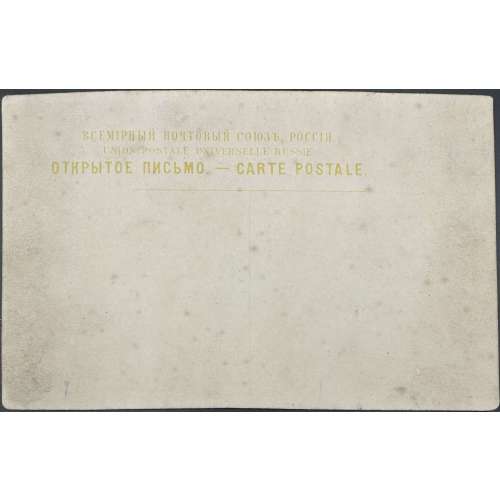 Ten postcards 90 x 140 mm, text in yellow "ВСЕМIРНЫЙ ПОЧТОВЫЙ СОЮЗЪ. РОССIЯ. | UNION POSTALE UNIVERSELLE RUSSIE. | ОТКРЫТОЕ ПИСЬМО. — CARTE POSTALE. || On the reverse, a blue ink woodcut image is printed in the upper left corner, and a blue ink numbered image title is in the bottom centre. Holding the postcard against the backlight reveals a hidden image of an indecent nature (erotic). The use of Latin characters "R" and "N" instead of Russian "Р" and "Н" suggests that the cards were produced in Europe, probably in France. Inscriptions: 1. ПЕRВЫЕ ДNИ; 2. ПОRА ЛЮБВИ; 3. ВЪ ЛЮДИ; 4. КЪ "СВОБОДNОМУ ИСКУССТВУ"; 5. "СВОБОДNЫЙ ТRУДЪ; 6. БЕЗЪ ГОRЯ И ПЕЧАЛИ; 7. NАЗАДЪ КЪ "СВОБОДNОЙ ЛЮБВИ"; 8. ВСЕ ЧТО ОСТАЛОСЬ!; 9. БЕЗЪ КRОВА И ПRИСТАNИЩА; 10. ИЗЪ ЗА ХЛѢБА.
Ten postcards 90 x 140 mm, text in yellow "ВСЕМIРНЫЙ ПОЧТОВЫЙ СОЮЗЪ. РОССIЯ. | UNION POSTALE UNIVERSELLE RUSSIE. | ОТКРЫТОЕ ПИСЬМО. — CARTE POSTALE. || On the reverse, a blue ink woodcut image is printed in the upper left corner, and a blue ink numbered image title is in the bottom centre. Holding the postcard against the backlight reveals a hidden image of an indecent nature (erotic). The use of Latin characters "R" and "N" instead of Russian "Р" and "Н" suggests that the cards were produced in Europe, probably in France. Inscriptions: 1. ПЕRВЫЕ ДNИ; 2. ПОRА ЛЮБВИ; 3. ВЪ ЛЮДИ; 4. КЪ "СВОБОДNОМУ ИСКУССТВУ"; 5. "СВОБОДNЫЙ ТRУДЪ; 6. БЕЗЪ ГОRЯ И ПЕЧАЛИ; 7. NАЗАДЪ КЪ "СВОБОДNОЙ ЛЮБВИ"; 8. ВСЕ ЧТО ОСТАЛОСЬ!; 9. БЕЗЪ КRОВА И ПRИСТАNИЩА; 10. ИЗЪ ЗА ХЛѢБА. -

Европейская поэзия XVII века. Библиотека всемирной литературы. Серия первая. М.: Художественная литература, 1977. 928 с. Вступительная статья Ю. Виппера. Тир. 303 000.
-
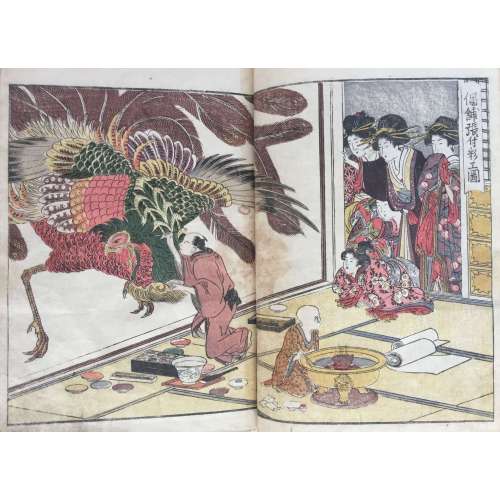 Seiro ehon nenju gyoji 青楼絵本年中行事 (A Picture Book of Annual Events in Yoshiwara). Block cut by: Fuji Kazumune (藤一宗). Printed by: Jakushodo Toemon (霍松堂藤右衛門). Written by: Jippensha Ikku (十返舎一九) (text, kyoka 4 & 12). Published by: Kazusaya Chusuke (上総屋忠助). Print artist: Kitagawa Utamaro (喜多川歌麿). Written by: Sandara Boshi (三陀羅法師) (kyoka 1). Workshop of: Yashiki no Katamaru (屋職堅丸). 1804 (spring); Edo. Reference: British Museum; Fine Arts Museums of San Francisco.
Seiro ehon nenju gyoji 青楼絵本年中行事 (A Picture Book of Annual Events in Yoshiwara). Block cut by: Fuji Kazumune (藤一宗). Printed by: Jakushodo Toemon (霍松堂藤右衛門). Written by: Jippensha Ikku (十返舎一九) (text, kyoka 4 & 12). Published by: Kazusaya Chusuke (上総屋忠助). Print artist: Kitagawa Utamaro (喜多川歌麿). Written by: Sandara Boshi (三陀羅法師) (kyoka 1). Workshop of: Yashiki no Katamaru (屋職堅丸). 1804 (spring); Edo. Reference: British Museum; Fine Arts Museums of San Francisco. -
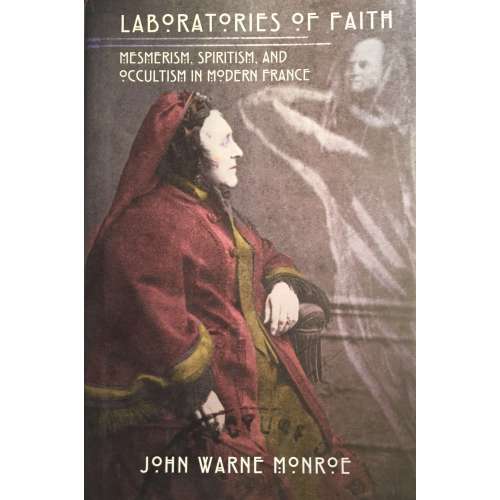
John Warne Monroe. Laboratories of Faith: Mesmerism, Spiritism, and Occultism in Modern France.
Cornel University Press, 2008.
ISBN: 9780801445620; Hardcover.
-
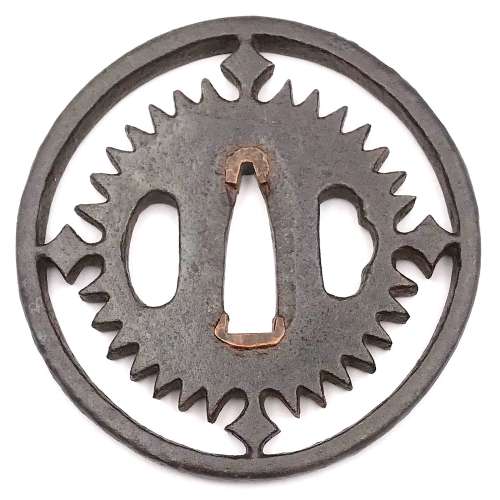 Iron tsuba of round form with design of slanting rays of light (shakoh) or clock gear (tokei) in openwork (sukashi). Commonly considered a Christian / Jesuit motif. Round-cornered rim. Copper sekigane. Momoyama period: Late 16th century (Tensho/Keicho era). Height: 72.5 mm, Width: 72.2 mm, Rim thickness: 5.5 mm, Center thickness: 5.3 mm. Round-cornered rim. Provenance: Sasano collection. Sasano Masayuki, Japanese Sword Guards Masterpieces from The Sasano Collection, Part I, № 136: "The general belief that this design represents the gear of a clock is erroneous, rather it shows the slanting rays of light from a cross, with the small diamond shapes representing the upright and transverse bars. The Christian influence is obvious..."
Iron tsuba of round form with design of slanting rays of light (shakoh) or clock gear (tokei) in openwork (sukashi). Commonly considered a Christian / Jesuit motif. Round-cornered rim. Copper sekigane. Momoyama period: Late 16th century (Tensho/Keicho era). Height: 72.5 mm, Width: 72.2 mm, Rim thickness: 5.5 mm, Center thickness: 5.3 mm. Round-cornered rim. Provenance: Sasano collection. Sasano Masayuki, Japanese Sword Guards Masterpieces from The Sasano Collection, Part I, № 136: "The general belief that this design represents the gear of a clock is erroneous, rather it shows the slanting rays of light from a cross, with the small diamond shapes representing the upright and transverse bars. The Christian influence is obvious..." -
 Iron tsuba of round form decorated with eight roundels - circular emblems of flowers and/or family crests (mon) made of cast brass, pierced and chiseled in kebori, and with flat brass inlay (hira-zōgan) of vines or seaweed all over the plate. Hitsu-ana outlined in brass. Four positive silhouette roundels are 3-, 4-, 5-, and 6- pointing crests/flowers; four negative silhouette roundels are bellflower, cherry blossom, and suhama. Yoshirō school (Kaga-Yoshirō). The Momoyama or early Edo period, beginning of 17th century. Size: diameter 77 mm, thickness 3,8 mm
Iron tsuba of round form decorated with eight roundels - circular emblems of flowers and/or family crests (mon) made of cast brass, pierced and chiseled in kebori, and with flat brass inlay (hira-zōgan) of vines or seaweed all over the plate. Hitsu-ana outlined in brass. Four positive silhouette roundels are 3-, 4-, 5-, and 6- pointing crests/flowers; four negative silhouette roundels are bellflower, cherry blossom, and suhama. Yoshirō school (Kaga-Yoshirō). The Momoyama or early Edo period, beginning of 17th century. Size: diameter 77 mm, thickness 3,8 mm -
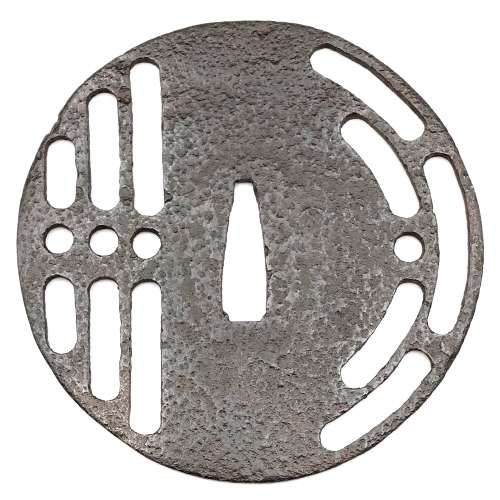 A very large and very thin iron tsuba of round form decorated with design of formalized butterfly and dragonfly in openwork (sukashi). The characteristics of the plate resemble those of Kamakura period ko-tōshō tsuba. However, the design seems too 'modern' to me, but it's hard to tell; it may be a late Muromachi or Momoyama period work. Tōshō or Ko-Tōshō school (or a Katchushi). Muromachi period. However, Boris Markhasin and Skip Holbrook insist this is a 20th-century machine-made tsuba. Dimensions: 99.6 x 100.5 x 2.1 mm. This is what Jim Gilbert says about old tsuba:
A very large and very thin iron tsuba of round form decorated with design of formalized butterfly and dragonfly in openwork (sukashi). The characteristics of the plate resemble those of Kamakura period ko-tōshō tsuba. However, the design seems too 'modern' to me, but it's hard to tell; it may be a late Muromachi or Momoyama period work. Tōshō or Ko-Tōshō school (or a Katchushi). Muromachi period. However, Boris Markhasin and Skip Holbrook insist this is a 20th-century machine-made tsuba. Dimensions: 99.6 x 100.5 x 2.1 mm. This is what Jim Gilbert says about old tsuba:"Traditionally the old iron plate tsuba are classified into Ko Tosho (old sword smith), and Ko Katchushi (old armor maker) styles. It is sometimes difficult to justify attribution of a given tsuba to the Tosho or Katchushi category. Generally guards with raised rims or relatively complex designs tend to be assigned to Katchushi. This is basically a convention we follow out of habit and convenience." [...] "In Token Kai-Shi part six, Articles by Akiyama Kyusaku, Robert Haynes comments: "…from 1300 to 1400 over 150,000 MOUNTED swords were made in Japan for export alone. This means that over four tsuba a day were made for 100 years. This would mean that at least 3000 persons were making nothing but tsuba, let alone all the other fittings needed to complete these swords. With sword smiths, fittings makers and all the other artists need to complete a sword for export, at least 10,000 sword artists were working together, in any one of these hundred years."
Another tsuba of similar design, Tōshō school, is illustrated in this collection; see TSU-0319.2015.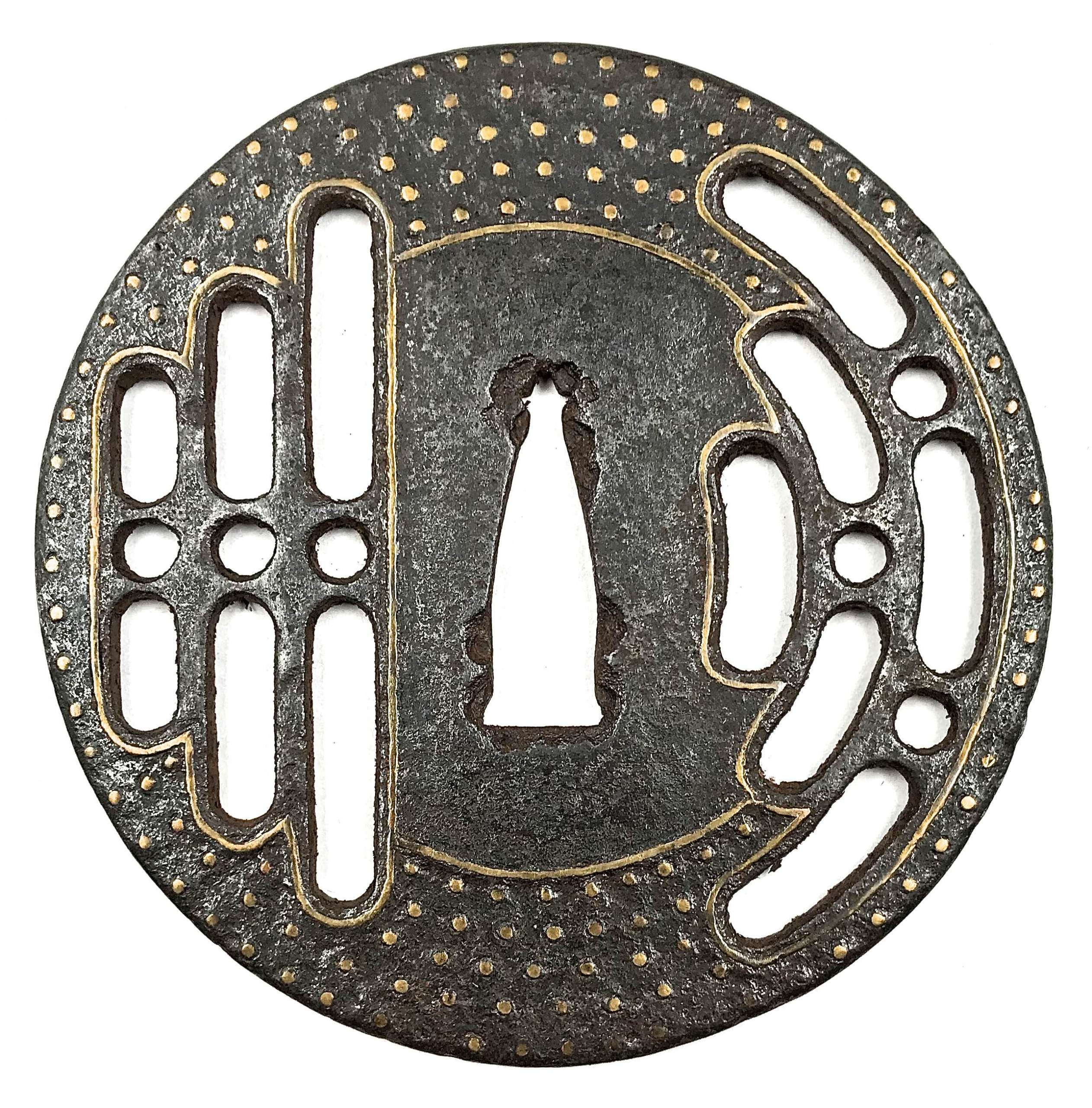 Reference to this design can be found in LIB-1359.2017 Japanese Swords and Tsuba from the Professor A. Z. Freeman and the Phyllis Sharpe Memorial collections, Sotheby's, London, Thursday 10 April 1997; p. 18-19, lot № 37: "A Kamakura-bori Tsuba, Momoyama Period. ...pierced with two large formalised butterflies..."
Reference to this design can be found in LIB-1359.2017 Japanese Swords and Tsuba from the Professor A. Z. Freeman and the Phyllis Sharpe Memorial collections, Sotheby's, London, Thursday 10 April 1997; p. 18-19, lot № 37: "A Kamakura-bori Tsuba, Momoyama Period. ...pierced with two large formalised butterflies..."

A Kamakura-bori tsuba of octagonal form, Momoyama period.
-

Iron tsuba of oval form with the design of two immortals (Gama Sennin with the toad upon his head and Tekkai Sennin with his iron crutch) beside a waterfall carved in low relief with a high relief effect (takabori) and with details inlaid in gold. A waterfall carved on the reverse. Nakago-ana is plugged with copper sekigane. Unsigned. Allegedly, Mito School.
Edo period, ca. 1700.
Size: Height: 87.0 mm; Width: 82.8 mm; Thickness: 4.4 mm; Weight: 179 g.
No longer available.


